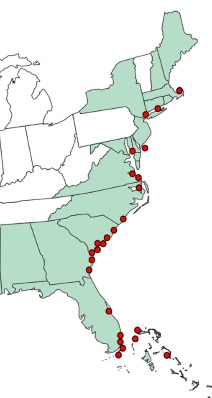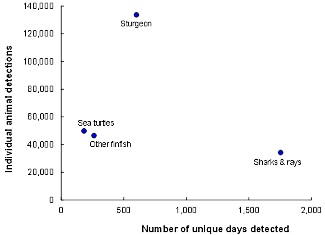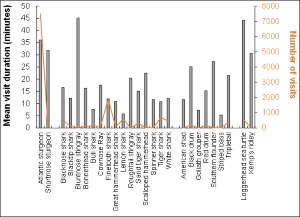Results

Between December 2013 and August 2016, nearly 800 transmitter-tagged animals were detected by at least one receiver in coastal waters off SC and GA. Nearly half of the animals detected were sturgeon (two species), the focus for the initial deployment of these receiver arrays. Approximately one-third of detected animals were sharks which spanned five of eight ASMFC Management Groups including prohibited take (two species), large coastal sharks (five species), hammerheads (two species), and two small coastal shark groups (three species). The remainder of animals detected comprised three ray species, two sea turtle species, and seven other finfish species.
The ability to detect such as diversity of tagged animals would not be possible without the efforts of numerous outside researcher groups, in this case 36 groups representing 10 states between Massachusetts and Florida and multiple Bahamian Islands. As such, it is the prerogative of these researchers to analyze and report the data collected for their tagged animals, and hence the reason that we only present (and with researcher consent) large-scale overview, seasonal, and spatial patterns herein to inform the most basic curiosities.

Collectively, more than 2,800 daily occurrences (and >264k individual detections) were recorded for these tagged animals during the first 32 months of acoustic monitoring. Across four broad taxonomic groupings, sturgeon had the highest detections per day rating. Conversely, sharks and rays were detected the most days but with the least overall amount of detection. The least number of detection days were associated with sea turtles and other finfish species, with similar detection rates between these two groups.

Nearly 15,000 unique visits to a receiver were recorded, with a visit defined as no more than 20 minutes elapsed between subsequent detections; this criteria was arbitrarily selected given that transmitters generally emitted signals at least every two minutes. Unique visits ranged in duration from a single detection to 66 consecutive hours, but across species typically spanned 19 minutes. Both sturgeon and both sea turtle species detected were associated with mean visit durations longer than 19 minutes, but only three of seven other finfish species and three of 15 shark and ray species had mean visit durations greater than 19 minutes.
